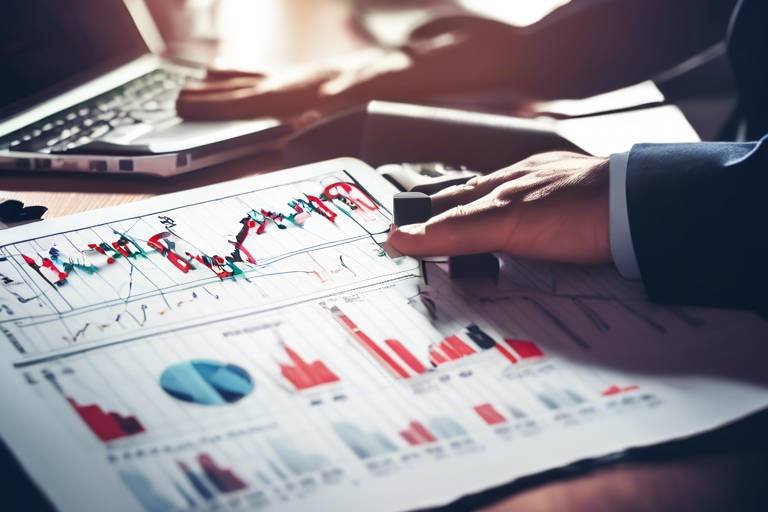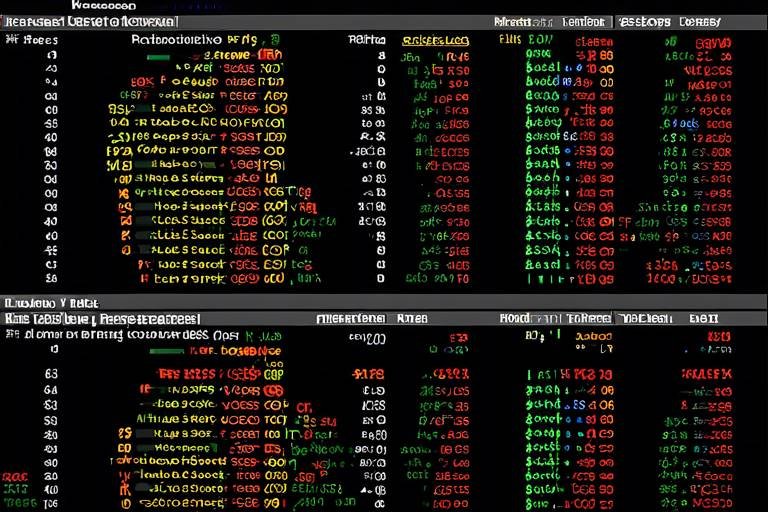The Importance of Staying Adaptable in Crypto Trading
In the fast-paced world of cryptocurrency trading, the only constant is change. If you're not ready to pivot and adjust your strategies, you might find yourself left behind. The significance of adaptability cannot be overstated; it is the lifeblood of successful trading in this volatile market. Imagine trying to navigate a stormy sea without adjusting your sails—inevitably, you'll capsize. The same principle applies to crypto trading, where market dynamics can shift in the blink of an eye, leading to unpredictable price movements. To thrive, traders must embrace a mindset that welcomes change rather than fearing it. This article delves into the critical aspects of adaptability in crypto trading, exploring strategies, market dynamics, and the mental fortitude required to succeed.
Market volatility is a defining characteristic of crypto trading. Prices can skyrocket one moment and plummet the next, leaving traders scrambling to keep up. But don't let this unpredictability scare you! Instead, think of it as a thrilling rollercoaster ride—full of ups and downs, but also opportunities for those brave enough to embrace the twists and turns. To navigate these unpredictable price movements, traders need to develop a keen sense for market dynamics. This means staying alert and being willing to adjust strategies on the fly. By understanding the factors that contribute to volatility, such as market sentiment, regulatory news, and technological advancements, traders can position themselves to capitalize on sudden changes.
A flexible trading strategy is crucial for success in the ever-evolving landscape of cryptocurrency. Just as a seasoned chef adjusts their recipe based on available ingredients, traders must create adaptable plans that can respond to market changes and unforeseen events. This requires a blend of analytical skills and instinct. Consider incorporating the following elements into your trading strategy:
- Regularly Review Your Strategy: The market is always changing, and your strategy should reflect that.
- Set Clear Goals: Know what you want to achieve, but be open to changing your approach if needed.
- Embrace Different Trading Styles: Whether day trading, swing trading, or holding long-term, be prepared to switch tactics.
By maintaining a flexible approach, traders can better navigate the tumultuous waters of crypto trading while seizing opportunities as they arise.
Effective risk management is essential in trading. Without it, even the most promising strategies can lead to significant losses. Think of risk management as your safety net; it’s there to catch you when things go wrong. Here are some key techniques to consider:
- Position Sizing: Determine how much of your capital you are willing to risk on a single trade.
- Setting Stop-Loss Orders: These are vital tools for protecting your investments, which we will explore further below.
- Diversifying Your Portfolio: This can help mitigate risks by spreading investments across various assets.
Stop-loss orders are essential for any trader looking to minimize potential losses. By setting a predetermined price at which your asset will automatically be sold, you can protect your investments from significant downturns. However, it’s important to adjust these orders based on market conditions. For instance, if a coin is experiencing a bullish trend, you might want to raise your stop-loss level to lock in profits while still allowing for potential gains.
Diversification can be a powerful tool in mitigating risks in crypto trading. Just like putting all your eggs in one basket is a risky move, concentrating your investments in a single cryptocurrency can expose you to greater volatility. By adapting your portfolio to include various assets—such as different cryptocurrencies, stablecoins, and even traditional assets—you can enhance your resilience against market fluctuations. This approach allows you to weather the storm when one asset takes a dive while benefiting from the growth of others.
In today's trading environment, technology plays a significant role in enhancing adaptability. From trading platforms to analytical tools, the right technology can help traders stay informed and responsive to market changes. Utilizing tools like real-time data feeds, charting software, and automated trading bots can provide traders with the edge they need to make quick decisions. By embracing these technological advancements, you can streamline your trading process and react faster to market movements.
Staying adaptable requires a commitment to continuous learning. The crypto market is ever-changing, and those who succeed are often the ones who can analyze market trends and adjust their strategies accordingly. Regularly reviewing market performance and identifying patterns can inform trading decisions and foster a proactive approach. This means not just reacting to market changes but anticipating them.
Data analytics can provide valuable insights into market behavior. By leveraging data, traders can make informed decisions that enhance their adaptability. For example, analyzing historical price movements can reveal trends and potential support or resistance levels. This knowledge allows traders to adjust their strategies effectively and capitalize on emerging opportunities.
Market news can significantly impact crypto prices, making it essential for traders to stay informed about global events. Whether it’s regulatory changes, technological advancements, or macroeconomic factors, being in the know can help you anticipate market movements and adjust your trading strategies accordingly. Following reliable news sources and participating in community discussions can provide you with the insights necessary to navigate the crypto landscape successfully.
Q: Why is adaptability so important in crypto trading?
A: Adaptability is crucial because the crypto market is highly volatile and can change rapidly. Traders who can adjust their strategies are more likely to succeed.
Q: What are some effective risk management techniques?
A: Effective techniques include setting stop-loss orders, position sizing, and diversifying your portfolio.
Q: How can technology help in trading adaptability?
A: Technology provides tools for real-time data analysis, automated trading, and market monitoring, all of which can enhance a trader's ability to respond quickly to changes.

Understanding Market Volatility
Market volatility is the beating heart of cryptocurrency trading; it’s what makes the crypto world both exhilarating and terrifying. Imagine riding a roller coaster that never stops—up one moment, down the next. This constant fluctuation is not just a characteristic of the market; it's a defining feature that traders must learn to embrace. Understanding market volatility is essential for anyone looking to navigate this unpredictable landscape successfully.
So, what exactly causes these wild price swings? Several factors contribute to the volatility of cryptocurrencies, including:
- Market Sentiment: The emotions and opinions of traders can lead to rapid price changes. Fear and greed are powerful motivators that can drive prices up or down in the blink of an eye.
- Regulatory News: Announcements regarding regulations can create panic or optimism, leading to drastic price movements.
- Technological Changes: Innovations or issues within the blockchain technology can impact investor confidence and price stability.
As a trader, understanding these factors is crucial. It’s not just about reacting to price changes but anticipating them. This requires a keen sense of observation and a willingness to adapt your strategies on the fly. For instance, when you notice a sudden surge in trading volume, it could signal a potential price spike. Instead of sticking to your original plan, you might want to consider adjusting your position or taking profits earlier than expected.
Moreover, it’s essential to recognize that not all volatility is bad. In fact, it can present opportunities for profit. By learning to read the market and understanding the underlying causes of price movements, you can position yourself to take advantage of these fluctuations. Think of it like surfing; the waves (market movements) can be unpredictable, but with the right skills and timing, you can ride them to success.
However, it’s also important to note that volatility can lead to significant losses if not managed properly. This is where having a solid trading plan comes into play. A well-thought-out strategy allows you to remain calm and collected, even when the market behaves erratically. You can use tools like technical analysis to gauge when to enter or exit trades, helping you to navigate through the chaos.
In summary, understanding market volatility is not just about recognizing the ups and downs; it’s about mastering the art of adaptability. Embrace the chaos, learn from it, and use it to your advantage. The more you understand the factors that drive volatility, the better equipped you will be to make informed trading decisions that can lead to success.

Developing a Flexible Trading Strategy
In the fast-paced world of cryptocurrency trading, having a rigid strategy is like trying to ride a unicycle on a tightrope—one misstep and you could find yourself in a precarious situation. To thrive in this environment, it's essential to develop a flexible trading strategy that can adapt to the ever-changing market dynamics. But what does that really mean? It means creating a plan that allows you to pivot quickly, respond to unforeseen events, and adjust your tactics based on real-time data.
First and foremost, a flexible trading strategy should be rooted in a solid understanding of your goals and risk tolerance. Ask yourself: What are you aiming to achieve? Are you looking for long-term gains, or are you more interested in short-term profits? Knowing your objectives will help you tailor your strategy. For instance, if you’re a day trader, you’ll need to be more responsive to market fluctuations than someone who is investing for the long haul.
One effective way to ensure adaptability is by incorporating a variety of trading styles into your strategy. This could mean blending day trading, swing trading, and even long-term investing into a cohesive plan. By diversifying your approach, you can take advantage of different market conditions. For example, during a bullish market, you might focus on short-term trades, while in a bearish market, you could shift to a more conservative, long-term strategy.
Moreover, it’s crucial to keep an eye on the market trends and news. The crypto landscape is influenced by a multitude of factors, from regulatory changes to technological advancements. Utilizing tools like market analysis platforms can provide you with insights that inform your trading decisions. By staying updated, you can adjust your strategy in response to new information. For instance, if a major exchange announces a new listing, it could be a good opportunity to capitalize on potential price surges.
Another key aspect of a flexible trading strategy is the ability to implement risk management techniques. This involves not just knowing when to enter a trade, but also when to exit. Setting stop-loss orders is a prime example of how you can protect your investments while remaining adaptable. By adjusting these orders based on market conditions, you can safeguard your profits and minimize losses.
To illustrate the importance of flexibility in trading, consider the following table that summarizes different trading strategies and their adaptability:
| Trading Style | Flexibility Level | Best For |
|---|---|---|
| Day Trading | High | Quick profits in volatile markets |
| Swing Trading | Moderate | Capturing medium-term trends |
| Long-Term Investing | Low | Steady growth over time |
Ultimately, developing a flexible trading strategy is about being prepared for the unexpected. It's about embracing the chaos of the crypto world and turning it into opportunities. By staying adaptable, you can navigate the ups and downs of the market with confidence and poise.
- What is a flexible trading strategy? A flexible trading strategy is one that can adapt to changing market conditions, allowing traders to pivot and adjust their tactics as needed.
- Why is adaptability important in crypto trading? The cryptocurrency market is highly volatile and influenced by various factors. Being adaptable helps traders respond effectively to these changes and minimize risks.
- How can I improve my trading strategy? Continuously analyze market trends, utilize data analytics, and incorporate risk management techniques to enhance your trading strategy.

Risk Management Techniques
When it comes to crypto trading, effective risk management is not just a nice-to-have; it's a necessity. The crypto market is notorious for its wild price swings, and without a solid risk management strategy, traders can find themselves in a precarious situation. Imagine sailing a ship in stormy seas without a map or compass—it's only a matter of time before you run aground. That's why understanding and implementing various risk management techniques can help you navigate these turbulent waters.
One of the most fundamental aspects of risk management is the risk-reward ratio. This ratio helps traders assess the potential profit of a trade against the possible loss. A good rule of thumb is to aim for a risk-reward ratio of at least 1:2. This means that for every dollar you're willing to risk, you should aim to make at least two dollars in profit. By maintaining this ratio, you can ensure that even if you have a few losing trades, your overall portfolio can still remain in the green.
Another crucial technique involves setting stop-loss orders. These are predetermined points at which you will exit a trade to prevent further losses. Think of it as a safety net; it allows you to limit your losses without having to constantly monitor the market. The beauty of stop-loss orders is that they can be adjusted based on market conditions. For instance, if a trade starts to move in your favor, you can tighten your stop-loss to lock in profits while still giving the trade room to grow. This adaptability is key to managing risk effectively.
Moreover, diversifying your portfolio can significantly enhance your risk management strategy. By spreading your investments across different cryptocurrencies and even other asset classes, you can reduce the impact of a poor-performing asset on your overall portfolio. For example, if you invest in a mix of established coins like Bitcoin and Ethereum, alongside some emerging altcoins, you create a buffer against volatility. This way, if one asset is underperforming, the others may help balance out your overall returns.
In addition to these strategies, it’s essential to maintain a disciplined approach to trading. This means sticking to your trading plan, avoiding emotional decisions, and not chasing losses. Emotional trading can lead to impulsive decisions that often result in greater losses. Instead, by adhering to a well-thought-out plan, you can make more informed decisions that align with your risk tolerance and trading goals.
Lastly, always remember that the market is constantly evolving. What worked yesterday may not work tomorrow. Therefore, it’s crucial to regularly review and adjust your risk management techniques. Stay adaptable, and don’t be afraid to tweak your strategies as the market changes. By doing so, you’re not just surviving the crypto trading landscape; you’re thriving in it.
- What is a risk-reward ratio? The risk-reward ratio is a measure used to compare the potential profit of a trade to its potential loss, helping traders make informed decisions.
- How do stop-loss orders work? Stop-loss orders automatically sell your asset when it reaches a certain price, limiting your losses without needing constant monitoring.
- Why is diversification important in crypto trading? Diversification helps mitigate risks by spreading investments across different assets, reducing the impact of a poor-performing investment.
- How can I stay disciplined in trading? Maintaining a trading plan, avoiding emotional decisions, and regularly reviewing your strategies can help you stay disciplined.

Setting Stop-Loss Orders
Setting stop-loss orders is one of the most crucial strategies in cryptocurrency trading. It’s like having a safety net that catches you when you fall, ensuring that your losses are minimized during those unpredictable market swings. Imagine you own a particular cryptocurrency, and the price is soaring. You might feel on top of the world, but what happens when the market suddenly takes a nosedive? Without a stop-loss order in place, your emotions can lead to hasty decisions that might wipe out your profits or even your initial investment.
So, what exactly is a stop-loss order? In simple terms, it's an order placed with your broker to sell a specific asset when it reaches a certain price. This price is typically below the current market price and is designed to limit your potential losses. By setting a stop-loss, you can effectively take the emotion out of trading and stick to your plan, which is essential for success in the volatile world of crypto.
Let’s delve deeper into how to set effective stop-loss orders. First, you need to determine the right price level at which to set your stop-loss. This often depends on your risk tolerance and trading strategy. For instance, if you’re a day trader, you might want to set tighter stop-loss levels to protect your capital from sudden fluctuations. On the other hand, long-term investors might opt for wider stop-loss levels to allow their investments some room to breathe.
Here are a few factors to consider when setting your stop-loss orders:
- Market Volatility: In a highly volatile market, like crypto, it’s essential to give your assets some breathing room. Setting a stop-loss too close to the current price can trigger unnecessary sales.
- Support and Resistance Levels: Analyze the chart for key support and resistance levels. Placing your stop-loss just below a strong support level can be a smart move.
- Percentage-Based Stops: Many traders use a percentage of their entry price to determine where to set their stop-loss. For example, if you buy Bitcoin at $40,000, you might set a stop-loss at 5% below that price, which would be $38,000.
Moreover, it’s important to remember that stop-loss orders are not foolproof. In extremely volatile markets, prices can "gap" past your stop-loss price, meaning your order could execute at a much lower price than expected. This phenomenon is often referred to as slippage. Therefore, understanding the market conditions and adjusting your stop-loss accordingly is vital.
In conclusion, setting stop-loss orders is not just a protective measure; it’s a fundamental aspect of a disciplined trading strategy. By incorporating stop-loss orders into your trading plan, you can navigate the turbulent waters of cryptocurrency trading with greater confidence and security. Remember, the goal is to protect your capital while allowing your investments the opportunity to grow. So, take the time to set your stop-loss orders wisely, and you’ll be better prepared to face the challenges of the crypto market.
What is a stop-loss order?
A stop-loss order is an instruction to sell a security when it reaches a certain price, designed to limit an investor's loss on a position.
How do I determine the right stop-loss level?
The right stop-loss level depends on your trading strategy, risk tolerance, and market volatility. Consider using support and resistance levels or a percentage of the entry price.
Can stop-loss orders guarantee my protection from losses?
No, while stop-loss orders can help limit losses, they do not guarantee protection, especially in fast-moving markets where slippage can occur.
Should I adjust my stop-loss orders over time?
Yes, as the market changes, it’s wise to reassess and adjust your stop-loss orders to align with your trading strategy and current market conditions.

Diversifying Your Portfolio
Diversification is like creating a safety net for your investments, especially in the unpredictable world of cryptocurrency trading. Imagine walking a tightrope; if you only have one rope to balance on, a gust of wind can send you tumbling. However, if you spread your weight across multiple ropes, you stand a better chance of maintaining your balance, even in turbulent times. In crypto, this means not putting all your eggs in one basket. By diversifying your portfolio, you can mitigate risks and enhance your potential for gains.
To effectively diversify, consider including a mix of different types of cryptocurrencies. For instance, you might want to invest in established coins like Bitcoin and Ethereum, which have a history of stability, alongside smaller, emerging altcoins that might offer higher returns. This strategy allows you to benefit from the growth potential of newer assets while maintaining a foundation of stability with more established currencies.
Moreover, diversification isn’t just about selecting various cryptocurrencies; it also involves considering the overall market conditions and trends. For example, during a bullish market, you might want to allocate more funds to high-risk, high-reward assets, whereas, in a bearish market, shifting your investments towards more stable options can help shield you from significant losses. This adaptability is crucial in ensuring that your portfolio remains resilient against market fluctuations.
Additionally, you should think about the geographical spread of your investments. Cryptocurrencies operate globally, and some may perform better in specific regions due to local regulations or market demand. By diversifying not only across different coins but also across different markets, you can further reduce the impact of localized downturns.
Here’s a simple table to illustrate how you might consider diversifying your crypto portfolio:
| Asset Type | Percentage Allocation | Rationale |
|---|---|---|
| Bitcoin | 40% | Stable and widely recognized |
| Ethereum | 30% | Strong use case with smart contracts |
| Emerging Altcoins | 20% | Potential for high returns |
| Stablecoins | 10% | Minimize volatility and provide liquidity |
In conclusion, diversifying your portfolio is not just a recommendation; it’s a necessity for anyone serious about crypto trading. By spreading your investments across different assets, market conditions, and geographical areas, you can create a robust strategy that adapts to the ever-changing landscape of cryptocurrency. Remember, the key to successful trading is not just about picking winners but also about managing risk effectively.
- What is portfolio diversification? Portfolio diversification involves spreading your investments across various assets to reduce risk.
- Why is diversification important in crypto trading? It helps mitigate risks associated with market volatility and can enhance potential returns.
- How can I diversify my crypto portfolio? Consider investing in a mix of established coins, emerging altcoins, and stablecoins while also looking at different geographical markets.
- What percentage should I allocate to different assets? It varies based on your risk tolerance, but a balanced approach often includes a mix of stable and high-risk assets.

Embracing Technological Tools
In the fast-paced world of crypto trading, technology isn't just a helpful addition; it's a game changer. As traders, we must leverage the latest tools and platforms to stay ahead of the curve. Think of it this way: if you were a chef, you wouldn’t just use a dull knife when there are high-quality, sharp tools available. Similarly, in crypto trading, using advanced technology can significantly enhance your efficiency and decision-making.
One of the most important technological tools in the crypto trader's arsenal is the trading platform. These platforms are not just interfaces for buying and selling; they come loaded with features that can help traders analyze market trends, execute trades swiftly, and manage their portfolios effectively. Popular platforms like Binance, Coinbase, and Kraken offer various functionalities, including real-time data and user-friendly interfaces, making it easier for traders to navigate the volatile market.
Moreover, charting software is another essential tool that traders should embrace. These tools allow you to visualize price movements and trends over time, offering insights that can inform your trading strategy. For instance, platforms like TradingView provide customizable charts that let you apply different indicators, such as moving averages and RSI (Relative Strength Index), to make informed decisions. Just like a pilot relies on instruments to navigate through turbulent skies, traders can use these charts to steer through unpredictable market conditions.
In addition to trading platforms and charting software, utilizing automated trading bots can also give traders a significant edge. These bots can execute trades based on predefined criteria, allowing you to capitalize on market opportunities even when you're not actively monitoring the market. Imagine having a tireless assistant who works around the clock to ensure you never miss a profitable trade. However, while bots can enhance your trading strategy, it's crucial to regularly review their performance and adjust parameters as necessary. After all, no tool is foolproof, and the market's dynamics are constantly changing.
Furthermore, staying informed is vital in the crypto world. This is where news aggregators come into play. Services like CoinDesk and CryptoSlate compile the latest news and developments in the cryptocurrency space, providing traders with the information they need to make timely decisions. The crypto market is often influenced by external factors, such as regulatory changes or technological advancements, and having access to real-time news can help you adapt your strategies accordingly. Think of it like having a weather app that alerts you to sudden storms; you wouldn’t want to be caught unprepared!
Lastly, don't underestimate the power of social trading platforms. These platforms allow traders to share insights, strategies, and experiences with one another. By following successful traders and learning from their approaches, you can adapt your strategies and improve your trading skills. It's akin to joining a community of like-minded individuals where you can exchange ideas and grow together, making the trading journey less isolating and more collaborative.
In conclusion, embracing technological tools is not just an option; it’s a necessity for anyone serious about succeeding in crypto trading. By integrating these tools into your trading routine, you can enhance your adaptability, make informed decisions, and ultimately, improve your trading outcomes. Remember, the crypto landscape is ever-changing, and those who adapt with the right tools will thrive.
- What are trading platforms? Trading platforms are online interfaces where traders can buy, sell, and manage their cryptocurrency investments.
- How do trading bots work? Trading bots automate the trading process by executing trades based on predefined algorithms and market conditions.
- What is social trading? Social trading allows traders to share strategies and insights with one another, often enabling less experienced traders to learn from experts.
- Why is staying updated with news important? Market news can significantly affect prices; being informed helps traders make timely and effective trading decisions.

Learning from Market Trends
In the fast-paced world of cryptocurrency trading, understanding and is not just beneficial; it's essential for survival. Imagine trying to navigate a ship through a storm without a compass. That’s what trading without a grasp of market trends feels like. The cryptocurrency market is notorious for its volatility, and the ability to read trends can mean the difference between making a fortune and suffering significant losses. By analyzing these trends, traders can identify potential opportunities and adjust their strategies accordingly.
One of the first steps in learning from market trends is to recognize the different types of trends that can occur. You might encounter:
- Uptrends: Characterized by rising prices, these trends indicate a bullish market.
- Downtrends: Marked by falling prices, these trends signal a bearish market.
- Sideways trends: When prices move within a range, indicating market indecision.
Understanding these trends allows traders to make informed decisions. For instance, during an uptrend, a trader might consider entering the market to capitalize on rising prices, while in a downtrend, they might look to short sell or stay out entirely. But how do you identify these trends? This is where data analytics and technical analysis come into play.
Utilizing tools like moving averages, trend lines, and momentum indicators can help traders visualize market trends. By plotting these indicators on a chart, you can see patterns emerge that might not be obvious at first glance. For example, a 50-day moving average can smooth out price fluctuations and help identify the overall direction of the market. When the price is consistently above this average, it suggests a strong uptrend, while prices below indicate a downtrend.
Moreover, staying updated with market news is equally crucial. Global events, regulatory changes, and technological advancements can dramatically shift market sentiment. For instance, a major country announcing a ban on cryptocurrency could lead to a sudden downtrend, while positive news about institutional investment might trigger an uptrend. By keeping an eye on the news, traders can adjust their strategies to align with the current market sentiment.
Another effective method to learn from market trends is to backtest your strategies against historical data. This process involves applying your trading strategy to past market conditions to see how it would have performed. By doing so, you can refine your approach, identify weaknesses, and gain confidence in your trading decisions. It's like rehearsing for a performance; the more you practice, the better you become.
In conclusion, is a dynamic process that requires attention, analysis, and adaptation. By leveraging data analytics, staying informed about global events, and consistently refining your strategies, you can navigate the unpredictable waters of cryptocurrency trading with greater confidence and success. Remember, the market is always changing, and so should your approach!
Q: How can I keep track of market trends effectively?
A: Utilize technical analysis tools, subscribe to crypto news outlets, and engage in trading communities to stay updated on market movements.
Q: What role does news play in market trends?
A: News can significantly influence market sentiment, causing rapid price changes. Staying informed allows you to anticipate potential market shifts.
Q: Is it necessary to use data analytics for trading?
A: While not mandatory, using data analytics can provide valuable insights and enhance your decision-making process, leading to better trading outcomes.

Utilizing Data Analytics
In the fast-paced world of cryptocurrency trading, data analytics has emerged as a game-changer for traders seeking to gain an edge. Imagine trying to navigate a vast ocean without a map; that’s what trading can feel like without the insights that data provides. By utilizing analytics, traders can uncover patterns, identify trends, and make informed decisions that can significantly impact their trading success.
Data analytics involves the systematic computational analysis of data sets to uncover trends, correlations, and insights. In the context of crypto trading, this means examining historical price movements, trading volumes, and other relevant metrics to forecast future price actions. Traders can leverage various tools and platforms that offer real-time data and analytics, transforming raw numbers into actionable intelligence.
For instance, traders can analyze the following data points:
- Price Trends: Observing historical price movements can help traders identify potential support and resistance levels.
- Trading Volume: Analyzing volume can indicate the strength of a price movement; high volume often signals a strong trend.
- Market Sentiment: Understanding how other traders feel about a particular cryptocurrency can provide insight into potential market movements.
Moreover, data analytics tools can help traders backtest their strategies. Backtesting involves applying a trading strategy to historical data to see how it would have performed in the past. This process not only builds confidence in a strategy but also highlights areas for improvement. Think of it as a rehearsal before the big performance; it’s all about fine-tuning your approach based on what the data reveals.
Another vital aspect of utilizing data analytics is the ability to adapt quickly. In the crypto market, conditions can change in the blink of an eye. Traders who rely solely on instinct may find themselves at a disadvantage compared to those who can pivot their strategies based on the latest data insights. By continuously monitoring analytics, traders can stay ahead of the curve and adjust their positions before market shifts occur.
In summary, embracing data analytics in crypto trading is not just beneficial; it's essential. The insights gained from data can lead to better decision-making, improved risk management, and ultimately, greater success in the volatile world of cryptocurrencies. So, if you haven’t already, it’s time to dive into the data pool and start swimming with the sharks!
Q: How can data analytics improve my trading strategy?
A: By analyzing historical price movements and market trends, data analytics helps you make informed decisions, identify potential entry and exit points, and refine your trading strategies based on empirical evidence.
Q: What tools are available for data analytics in crypto trading?
A: There are numerous tools available, such as TradingView, CoinMarketCap, and CryptoCompare, which provide real-time data, charts, and analytics to help traders make informed decisions.
Q: Is data analytics only for experienced traders?
A: Not at all! While experienced traders may leverage advanced analytics, beginners can also benefit from basic data analysis to understand market trends and improve their trading strategies.
Q: How often should I analyze data?
A: Regular analysis is key. It’s advisable to review data frequently, especially during periods of high market volatility, to stay informed and adjust your strategies accordingly.

Staying Updated with News
In the fast-paced world of cryptocurrency trading, staying updated with the latest news is not just a good practice; it’s absolutely essential. The crypto market is heavily influenced by global events, regulatory changes, technological advancements, and even social media trends. Imagine trying to sail a ship without knowing the weather forecast—it's a recipe for disaster! Similarly, traders who ignore the news can find themselves caught off guard by sudden price fluctuations.
One of the best ways to keep your finger on the pulse of the market is to follow reputable news sources. Websites like CoinDesk, The Block, and CoinTelegraph provide timely updates and in-depth analysis on the latest happenings in the crypto world. By regularly checking these sources, you can gain valuable insights that might affect your trading strategies.
Additionally, social media platforms like Twitter and Reddit can be incredibly useful for gathering real-time information. Many influential figures in the crypto space, including developers and analysts, share their thoughts and insights on these platforms. However, it’s crucial to approach this information with a critical mindset. Not every tweet or post is reliable, so always cross-reference with trusted news outlets.
To make the most of your news consumption, consider setting up alerts for specific keywords related to your investments. For instance, if you’re trading Bitcoin, you could set alerts for terms like “Bitcoin regulation,” “Bitcoin adoption,” or “Bitcoin market analysis.” This way, you can receive notifications directly to your phone or email whenever news breaks, allowing you to react swiftly to any developments.
Furthermore, attending webinars and online forums can enhance your understanding of the market. These platforms often feature expert speakers who discuss current trends and provide forecasts based on news events. Engaging in discussions with fellow traders can also help you gain different perspectives and improve your adaptability.
In summary, staying updated with news is not just about being informed; it’s about empowering yourself to make better trading decisions. The more informed you are, the more effectively you can adapt your strategies to align with market conditions. After all, in the world of crypto trading, knowledge truly is power!
- Why is staying updated with news important in crypto trading?
Staying updated helps traders anticipate market movements and adjust their strategies accordingly, reducing the risk of unexpected losses. - What are some reliable sources for crypto news?
Reputable sources include CoinDesk, The Block, CoinTelegraph, and various financial news websites. - How can I set up alerts for crypto news?
You can use news aggregator apps or set alerts on platforms like Google News for specific keywords related to your interests in cryptocurrency. - Should I trust social media for crypto news?
While social media can provide real-time updates, it’s essential to verify information from trusted news sources before making trading decisions.
Frequently Asked Questions
- What is market volatility in crypto trading?
Market volatility refers to the rapid and unpredictable price movements that are common in the cryptocurrency market. This can be caused by various factors, including news events, market sentiment, or changes in technology. Understanding volatility is crucial for traders as it helps them navigate the ups and downs effectively.
- How can I develop a flexible trading strategy?
To create a flexible trading strategy, start by setting clear goals and defining your risk tolerance. Incorporate various trading techniques, such as day trading, swing trading, or long-term investing, and be prepared to adjust your approach based on market conditions. Regularly review and refine your strategy to ensure it remains effective.
- What are some effective risk management techniques?
Effective risk management techniques include setting stop-loss orders, diversifying your portfolio, and only risking a small percentage of your capital on each trade. These strategies help protect your investments and minimize losses while allowing you to capitalize on potential gains.
- How do stop-loss orders work?
Stop-loss orders are automated instructions to sell an asset when it reaches a certain price. This helps limit potential losses in a volatile market. You can adjust these orders based on market conditions to ensure your investments are protected as prices fluctuate.
- Why is diversification important in crypto trading?
Diversification involves spreading your investments across various assets to reduce risk. In crypto trading, this means holding different cryptocurrencies rather than putting all your funds into one. By adapting your portfolio to include a variety of assets, you can enhance resilience against market fluctuations.
- What technological tools can help with trading adaptability?
There are several tools available, including trading platforms, market analysis software, and mobile apps that provide real-time data and alerts. Utilizing these technologies can help you stay informed and responsive to market changes, making it easier to adapt your trading strategies.
- How can I learn from market trends?
Analyzing market trends involves studying historical price movements, trading volumes, and overall market sentiment. By understanding these patterns, you can make more informed trading decisions and adapt your strategy proactively to changing market conditions.
- Why is staying updated with news important for traders?
Market news can significantly impact cryptocurrency prices. Events such as regulatory changes, technological advancements, or economic shifts can lead to price volatility. Staying informed about global events allows traders to adjust their strategies accordingly and seize potential opportunities.



















